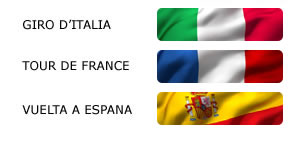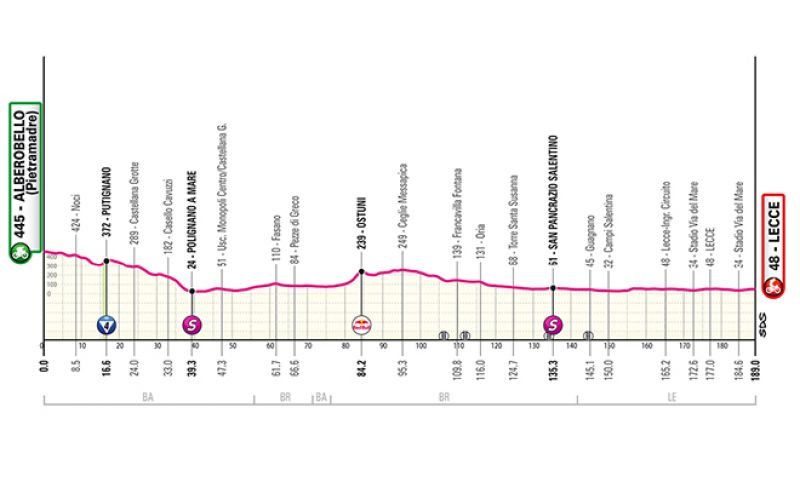

The Giro d'Italia has landed in the Peninsula after the first three stages in Albania and restarts from Puglia. The fourth stage starts from Alberobello and arrives in Lecce after 189 kilometers.
to follow the live coverage of the entire stage starting at 12:55 CLICK HERE
It's a flat stage - the first of this edition dedicated to sprinters - with only a brief climb in Putignano at the beginning of the day, the only GPM scheduled, and even that of 4th category. The route passes through the main cities of the area via wide and essentially straight roads.
The flying sprints are located in Polignano a Mare after 39 km and in San Pancrazio Basentino after 135. In Lecce, riders enter the final circuit just after the arrival. They will cover almost the entire circuit of about 12 km before crossing the finish line and completing a full lap. In the finale, there is only one significant turn about 1200 m from the finish, with the last kilometer slightly curving to the left until the final 300-meter straight.
THE TERRITORY. There are more than a thousand trulli that make Alberobello a unique town in the world, not by chance included by UNESCO in the World Heritage Sites. Before setting out to follow the riders along the route, it's worth exploring the sloping streets of the Monti and Aia Piccola districts: here there are trulli of all types, from places of worship to private homes, usually on one floor with the exception of the grand Trullo Sovrano. Unique is the architectural complex housing the Territorial Museum "Casa Pezzolla", formed by 15 interconnected trulli located on the eastern side of XXVII Maggio square. Inside, you can admire traditional furnishings, while in some rooms the main productive activities of the area are illustrated, from viticulture to grain cultivation.
The fourth stage of the Giro 2025 winds almost entirely through Salento, one of the most fascinating regions of Southern Italy. In Putignano, home to one of Italy's most lavish Carnivals, one can get acquainted with one of the excellences of Puglia's renowned cheese production, caciocavallo, also made with buffalo milk. Castellana Grotte offers the opportunity to take a journey to the center of the Earth, following a path of about 3 kilometers inside the magnificent karst complex adorned with spectacular stalactites and stalagmites.
Arriving on the coast, the first stop not to be missed is Ostuni, the White City. Even a distracted glance is enough to understand the reason for the nickname. It's a dazzling whiteness that one immerses in while exploring the historic center protected by the Aragonese walls: this labyrinth of courtyards, alleys, small squares, and staircases provides a single color: white, precisely, the color of lime used for centuries to plaster the facades. The walk also allows discovering the workshops of ceramic masters and olive wood sculptors, who perpetuate a centuries-old tradition and have now become ambassadors of Apulian artisan expertise.
In Francavilla Fontana, the imposing Imperiali Castle (15th century) can be admired, but it's also hard to resist visiting one of the many pastry shops to taste typical local sweets like copeta, a crunchy almond glaze, and ricci confetti, toasted almonds covered in sugar.
The vineyards cradle of Negroamaro accompany you to Novoli, not by chance a commune of the Wine Cities, and shortly after you arrive in Lecce, sumptuous capital of Baroque, where the day's finish line is located.
The sparkle of Baroque, here truly more glittering than ever, has catapulted Lecce into the ranks of art cities to visit at least once in a lifetime. If time is short, some painful choices must be made. So you start from Piazza Sant'Oronzo, the heart of the city, where among other things you can admire the Roman Amphitheater carved into the tuff that could host 25,000 spectators. Then you move to Piazza del Duomo, surprising for its dimensions and stunning for the spectacle offered by the Baroque building complex, starting with the Cathedral dedicated to the Assumption. And here, finally, the powerful 16th-century Castle. Outside its walls is the Harmony Fountain with its precious bronze group allegorical of youth and love. No place is better to refill the water bottle.

Se sei giá nostro utente esegui il login altrimenti registrati.